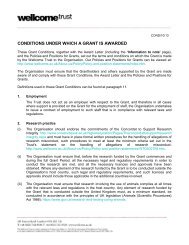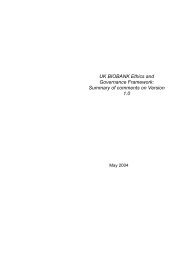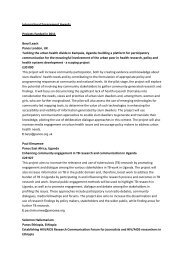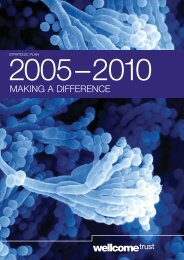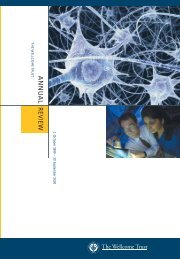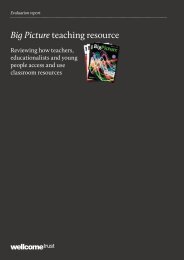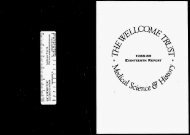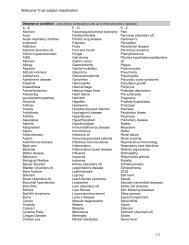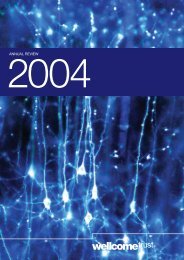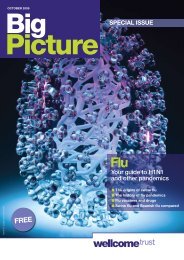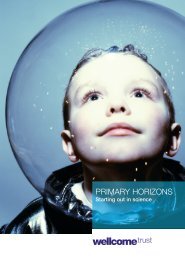Create successful ePaper yourself
Turn your PDF publications into a flip-book with our unique Google optimized e-Paper software.
26 | ENGAGING SCIENCE<br />
Happy anniversary<br />
Cut and thrust<br />
<strong>Wellcome</strong> Collection attracted more than<br />
300 000 visits in its first year of opening.<br />
Neurosurgery and the sinking of the<br />
Mary Rose have been the focus of two<br />
acclaimed documentaries.<br />
1 2<br />
<strong>Wellcome</strong> Collection, opened in June<br />
2007, offers visitors a unique chance<br />
to explore different cultural fields<br />
inspired by science, and to debate<br />
and discuss wider social issues. An<br />
eventful year saw innovative<br />
exhibitions on sleeping and<br />
crystallography-inspired design, as<br />
well as a deeply moving photographic<br />
exhibition of terminally ill people. The<br />
visitor numbers far exceeded<br />
expectations and, combined with a<br />
string of plaudits from critics,<br />
amounted to a highly successful first<br />
year of operations.<br />
The first new temporary exhibition of the<br />
year, Sleeping & Dreaming, a partnership<br />
with the Deutsches Hygiene-Museum,<br />
Dresden, brought together works from<br />
artists, scientists, film makers and<br />
historians, illuminating a ubiquitous but<br />
mysterious aspect of human behaviour.<br />
Life Before Death, a series of 24 sets of<br />
photographs taken of terminally ill people<br />
before and after their deaths, resulted<br />
from a collaboration between journalist<br />
Beate Lakotta and photographer Walter<br />
Schels. Featured on the Guardian<br />
website, it broke the newspaper’s record<br />
for the highest number of hits in a<br />
24-hour period.<br />
By complete contrast, From Atoms to<br />
Patterns included ‘insulin wallpaper’ and<br />
other intriguing designs from the 1951<br />
Festival of Britain, all inspired by X-ray<br />
crystallography. The final exhibition of the<br />
year, Skeletons: London’s buried bones,<br />
featured 26 skeletons from the Museum<br />
of London’s Centre for Human<br />
Bioarchaeology, collectively uncovering<br />
2000 years of London’s history.<br />
The temporary exhibitions were<br />
complemented by a lively events<br />
programme, which included debates<br />
about organ donation, obesity and<br />
genetic tests, performances of a play<br />
exploring chronic fatigue syndrome and<br />
a festival to launch The Big Draw 2008.<br />
The exhibitions and events met with<br />
wide-reaching critical attention from<br />
national and international media. As a<br />
contributor to the Rough Guide website<br />
put it: “<strong>Wellcome</strong> Collection is a small,<br />
eclectic, imaginative, humane, humorous<br />
exhibition of objects related, sometimes<br />
in the loosest sense, to medicine. It is<br />
WONDERFUL.”<br />
<strong>Wellcome</strong> Collection was also one of<br />
only four venues shortlisted for this year’s<br />
prestigious Art Fund Prize, a national<br />
award given to a public venue whose<br />
project demonstrates the most<br />
originality, imagination and excellence.<br />
They are two compelling stories. The<br />
English Surgeon documents the<br />
attempts of a leading brain surgeon<br />
struggling to save lives in Ukraine. In<br />
complete contrast, The Ghosts of the<br />
Mary Rose: Revealed describes how<br />
forensic analysis of sailors’ remains<br />
may explain the dramatic sinking of<br />
the Mary Rose in 1545.<br />
Henry Marsh first visited Kiev in 1992,<br />
and was horrified by the conditions<br />
endured by both patients and doctors.<br />
Since then he has made at least two trips<br />
a year – taking time off as a consultant at<br />
St George’s Hospital – to work with<br />
Ukrainian neurosurgeon Igor Petrovich.<br />
The English Surgeon, funded by a<br />
<strong>Wellcome</strong> <strong>Trust</strong> People Award, was<br />
produced by Geoffrey Smith and<br />
screened on BBC2 in April 2008 to<br />
critical acclaim. Time Out called it “a<br />
life-affirming, unforgettable portrait of a<br />
true humanitarian”, and the Guardian<br />
described it as “a lovely, lovely film”. It<br />
won Best International Feature<br />
Documentary at HotDocs 2008.<br />
Shot over two chaotic weeks in the 2007<br />
Ukrainian winter, the film shows Marsh<br />
agonising over whom he can and cannot<br />
save – and struggling with local logistical<br />
and political constraints. At one point he<br />
has to use a £30 cordless drill to bore<br />
into a patient’s skull. Remarkably, the<br />
operation is a success.<br />
Images<br />
1 T h e Life Before Death exhibition.<br />
2 T h e From Atoms to Patterns exhibition.<br />
3 Hugh Montgomery, examining the remains of a Mary Rose sailor.<br />
4 Professor John Holman, Director of the<br />
National Science Learning Centre.<br />
5 A practical demonstration at the launch<br />
of Project Enthuse.



